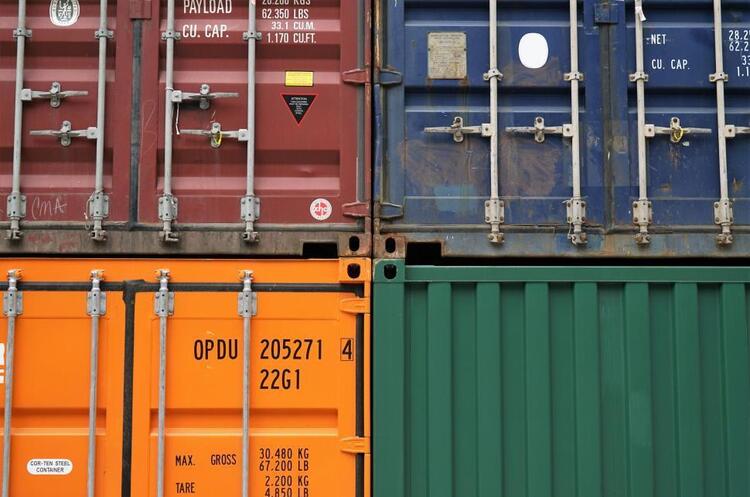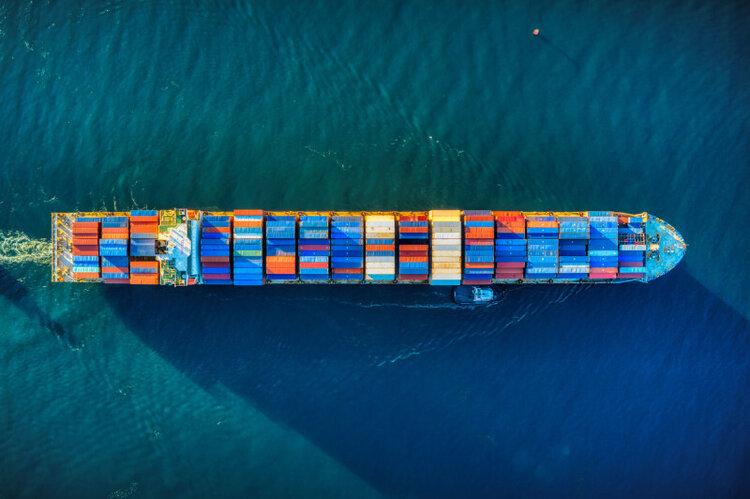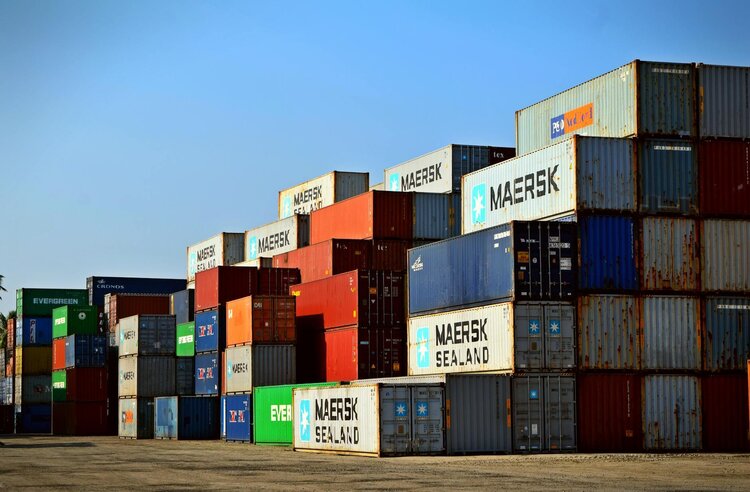"With direct port calls, we are moving toward lower freight costs." How Ukraine's maritime container market is recovering
Two more international container operators, CMA CGM and Medkon Lines, have launched regular shipments to Odesa

This month, the newsmakers of Ukraine's maritime and logistics industry were the French container line CMA CGM and the Turkish Medkon Lines, which, for the first time since Russia's full-scale invasion, began vessel calls at the Port of Odesa.
While acknowledging the role of regional Turkish operators, it is important to highlight the significance of the return of the French giant – the third-largest player in the global market – which has been the most anticipated event since the launch of services by Swiss MSC and Danish Maersk last year.
Now, the "Big Three" container operators fully support regular connections to the ports of Greater Odesa. Their services expand Ukraine's integration into the global container network, contribute to stabilizing rates, enhance operational capabilities, and send a positive market signal. Mind explored the efforts behind the restoration of maritime container traffic, how container flow metrics are evolving, and the changes in container shipping costs through the ports of Greater Odesa.
At the beginning of February 2025, two container ships arrived at the Port of Odesa over the course of two days. First, the small vessel T Moon (with a capacity of 350 TEU) docked, followed by the larger container ship Lila Canada (1,118 TEU).
With its first vessel call, the container operator Medkon Lines launched a regular service from the Turkish ports of Ambarlı (Istanbul) and Gebze to Odesa. "We will continue to maintain strong ties with Ukraine in maritime transportation and provide reliable logistics solutions," the Turkish line stated, commenting on the event.
The voyage of the larger vessel marked the start of CMA CGM’s regular service, which, for the first time since the full-scale invasion, established a direct connection between Greece and Ukraine. The route runs from Piraeus, Greece, to Odesa, with return calls at the already mentioned Turkish port of Ambarlı. Piraeus is one of the largest container hubs in the Mediterranean, where more than 20 other regular services of the French operator intersect.
It is expected that the CMA CGM service will be operated by two container ships. The declared duration of a full round trip is 14 days.
Another important milestone: with the return of CMA CGM, the Odesa container terminal "Brooklyn-Kyiv Port" resumed container handling for the first time since the start of the war. Medkon vessel calls are being handled by the Odesa Container Terminal (KTO), which resumed processing container ships after MSC reopened its service in July last year.
"The return of major shipping lines like CMA CGM, along with MSC and Maersk last year, indicates a gradual restoration of confidence in Ukrainian ports, contributing to stabilizing freight rates and improving services," Pavlo Lynnyk, CEO of logistics company Global Ocean Link (GOL), told Mind.
Before the full-scale invasion, CMA CGM and Medkon Lines operated in Ukraine, though their market shares differed significantly, reflecting their respective positions in the global container shipping industry. While the French operator is one of the global market leaders, the Turkish company operates at a regional level, balancing between the first and second hundred in the global ranking.
What should you know about CMA CGM?
CMA CGM ranks third among the world's largest container shipping lines. The carrier operates over 660 container ships, including 310 owned vessels, with a total capacity of 3.875 million TEU, controlling over 12% of the global market. The company operates in 160 countries, serving approximately 260 regular routes across all major trade lanes, covering 420 ports. Its annual shipping volume in recent years has reached around 22 million TEU.
CMA CGM’s leadership ambitions are demonstrated by one of the industry’s largest order books for new vessel construction – an indicator of fleet renewal and expansion. As of February 2025, the company has over 90 container ships on order, with a total capacity exceeding 1.5 million TEU. Given the small share of outdated vessels and lower activity from competitors in the shipbuilding market, the French line is challenging Denmark’s Maersk, which holds the second position in the global ranking.
Before the full-scale war, CMA CGM was the third-largest player in Ukraine’s maritime container market, following Maersk and MSC in container volumes. The line transported around 120,000–130,000 TEU annually during the three pre-war years when Ukrainian seaports handled over 1 million TEU. Its services were accommodated at the Brooklyn-Kyiv Port container terminal in Odesa. Since 2008, CMA CGM owned 50% of the terminal. In 2020, this stake was acquired by the container terminal operator Terminal Link (headquartered in Marseille), in which CMA CGM holds a 51% share, while Chinese terminal operator China Merchants Port owns 49%.
After the war began, CMA CGM’s Ukrainian traffic was redirected through ports in Poland, Romania, Lithuania, Germany, the Netherlands, Belgium, Slovenia, and Croatia, as well as Danube ports. According to the company’s presentation materials, the volume of Ukrainian container traffic in 2023 reached 60,000 TEU, up from 40,000 TEU in 2022.
What is Medkon Lines?
The Turkish Medkon Lines (headquartered in Istanbul) represents a significantly smaller scale of container business. The Medkon Group entered the maritime logistics sector in 2009, and in the following years, container shipping became its core business.
The line offers 16 regular container services covering the Mediterranean, Black, and Red Seas. The carrier operates 23 container ships, including 17 owned vessels, and a container fleet with a total capacity of 35,000 TEU.
The Odesa service is one of the latest additions Medkon has introduced, reconnecting Ukraine to its network. Before the full-scale war, the line operated in the Ukrainian market for about six months – launching a service in August 2021 that connected Odesa with Istanbul and several Mediterranean ports. As it does now, vessel calls were handled by the Odesa KTO terminal.
"Turkish lines are returning to Ukraine. While Medkon is a small Turkish line focused solely on the Mediterranean region, they promise to compete aggressively on rates and transit times," said Volodymyr Huz, Commercial Director of logistics company GOL, in an interview with Mind.

How Were Container Shipments to Greater Odesa Restored?
Before the invasion, Turkish shipping lines held a significantly smaller share of the Ukrainian maritime market compared to global giants – between 2019 and 2021, their combined market share amounted to just a few percent. However, credit is due to Turkish players, who were among the first to seek opportunities to establish regular shipments to Danube region ports, thereby restoring container connectivity through Ukrainian ports.
One of the market participants that managed to organize such a connection as early as 2022 was another Turkish shipping line – Akkon Lines. The carrier launched a direct service to the port of Izmail using its own vessel. "This made it possible to ship goods directly to China and other Asian countries," said Huz.
Other international lines, traditionally active in the Ukrainian market, developed their logistics networks on the Danube, particularly by utilizing feeder connections between Romania's Constanța and Ukraine’s Danube ports. This feeder service was introduced by the Ukrainian transport and logistics company Iteris.
In April 2024, the expansion of Iteris' feeder operations to the port of Chornomorsk marked the return of container ships to the ports of Greater Odesa for the first time since the start of the full-scale war and eight months after the opening of the Ukrainian Maritime Corridor. The new feeder connection between Constanța and Chornomorsk began to be used by MSC, Maersk, CMA CGM, Hapag-Lloyd, Evergreen, and several other shipping lines.
Meanwhile, Akkon Lines planned to commence vessel calls to Chornomorsk. It was the first to launch a weekly direct service to the ports of Odesa. The connection between several Turkish ports and Chornomorsk began operating at the end of June, and within a few months, the service was already being operated by three vessels.
How Did Global Leaders Restore Services to Odesa Ports?
However, the market was already expecting more – the resumption of direct calls by global giants using their own fleets. The first to establish such a connection was the world market leader, the Swiss company MSC, which launched a direct service from the Turkish port of Tekirdağ to the port of Odesa. Although the first voyage had to be postponed due to increased inspections of export cargo and delays in customs clearance of containers, the landmark industry event eventually took place – in July, the company’s own container ship, Levante F (1080 TEU), made its first call at the Odesa KTO terminal.

Amid MSC’s return, another story was unfolding, linking the company to Ukraine’s container market. In November, MSC became the owner of 49.9% of the German logistics group HHLA, which owns the Odesa KTO terminal. The primary interest for the Swiss company was HHLA’s largest assets – three container terminals in the port of Hamburg. The deal took over a year to finalize and was completed only after approval by Ukraine’s Antimonopoly Committee. Initially, the regulator identified risks of container handling monopolization at the port of Odesa and launched an investigation. It then proposed commitments for the deal participants to mitigate its potential negative impact on competition, ultimately granting approval.
The opening of the next service took several more months. Unfortunately, in October, Russian aggressors intensified attacks on port infrastructure. Notably, during the shelling of the port of Chornomorsk on October 9, the container ship Shui Spirit was hit, resulting in casualties. The vessel was operating a routine voyage as part of Iteris’ feeder service.
Shortly afterward, Maersk announced the launch of a new weekly service from Egypt’s Port Said to Chornomorsk. As the company stated, its opening would be “a significant step in improving connectivity and efficiency” for Ukrainian customers. The first voyage to Chornomorsk took place in early November. The service is operated by container ships A. Obelix (1698 TEU) and Harrison (1216 TEU).
This service utilizes a feeder connection from the international feeder service provider Unifeeder, which is owned by the global container terminal operator DP World (headquartered in Dubai). Since 2020, the Emirati giant has held a controlling stake in the TIS container terminal (now DP World TIS Pivdennyi), which handled the majority of Maersk’s container traffic in Ukraine before the invasion.
"It is worth noting the silence of other major shipping lines that operated in Ukraine before the war. Among them, for example, are the Chinese COSCO and Japanese ONE, which currently bypass our region. They remain completely silent. Yes, they can be booked through Romania and Poland, but there are still no direct vessel calls. Not even prospects," noted Huz.
Meanwhile, another Turkish shipping line, Arkas, is considering resuming a direct service. Before the war, Arkas handled the largest container volume among Turkish carriers in Ukraine. "Last year, Arkas returned to Greater Odesa along with the Iteris feeder service, launched in April 2024. This service is still in operation, but cargo volumes have decreased. It is known that Arkas is discussing the possibility of a direct vessel call, but there is no concrete information yet," said GOL’s commercial director.
How Much Container Traffic Did Ports Handle Last Year?
The gradual restoration of container connections to Greater Odesa after more than two years of disruption nearly doubled the volume of container handling at Ukrainian seaports in 2024.
According to data from the Ukrainian Sea Ports Authority (USPA) provided to Mind, Ukrainian seaports increased container throughput by 92% compared to the previous year: 129,902 TEU were handled, compared to 67,667 TEU in 2023, when maritime container traffic was limited to the Danube cluster ports.
Ports of Greater Odesa processed 71% of the annual volume during their partial year of resumed container handling – 92,461 TEU. This new benchmark highlights the efforts required to restore the maritime container market. It is worth noting that last year’s total volume is roughly equivalent to the average monthly volume processed by seaports before the invasion.
Meanwhile, the Danube cluster ports saw a 45% year-over-year decline in container throughput, decreasing by 30,226 TEU to 37,441 TEU.
The statistics also indicate that export container traffic exceeds import traffic: last year, exports reached 68,732 TEU, while imports stood at 59,471 TEU. The previous year, exports amounted to 35,044 TEU, and imports to 32,576 TEU.
How Has the Cost of Container Shipping Through Greater Odesa Ports Changed?
"As of February 2025, the cost of container shipping through the ports of Greater Odesa is competitive compared to European alternatives, such as Constanța. In particular, shipping through our ports allows for minimized costs associated with using road or rail transport," said GOL’s CEO, Lynnyk.
Freight rates for transporting a 20-foot container from the ports of Greater Odesa, Constanța, and Gdańsk to ports in China, $
| April 2024 | August 2024 | November 2024 | February 2025 | |
| Ports of Greater Odesa | 2000–2200 | 1800–2000 | 1300–1500 | 900–1000 |
| Constanca | 1300–1400 | 1000–1100 | 400–500 | 250–300 |
| Gdansk | 200–300 | 100–200 | 50–100 | 50–100 |
Source: GOL
Immediately after the resumption of container traffic to the ports of Greater Odesa, the cost of exporting a container was significantly higher than through Romania and Poland.
"However, over the past year, pricing has started to integrate into the system, and rates have gradually decreased. Currently, export shipments from our ports remain more expensive than through Constanța due to security risks. However, with direct vessel calls, we are gradually moving toward lowering freight costs – at least to align tariffs with Romania, as it was before the war," notes Huz.
"That said, we shouldn't expect export rates from our ports, for example, to the Far East region, to be the same as from Poland – 'direct' ports will always be cheaper. Therefore, we need to compare the overall logistics cost, such as from Kyiv to the final destination port," added the commercial director of GOL.
Speaking about the import direction, Huz recalled the global market trends over the past year. "Last year, the market was affected by the terrorist activity of Yemeni Houthis, who effectively 'restructured' the global container shipping economy," he says. "Major shipping lines began rerouting around Africa, which led to increased freight rates and transit times. Rates spiked sharply, peaking in June and July. However, they later started to decline. By January 2025, they nearly returned to pre-Houthi levels.
However, a 50% increase is expected in March. As a result, imports through our ports remain expensive. Next month, rates on routes from Chinese ports to Greater Odesa are expected to be at $2,200–2,400 per 1 TEU and $3,500–3,800 per 1 FEU."
If you have read this article to the end, we hope that means it was useful for you.
We work to ensure that our journalistic and analytical work is of high quality, and we strive to perform it as competently as possible. This also requires financial independence. Support us for only UAH 196 per month.
Become a Mind subscriber for just USD 5 per month and support the development of independent business journalism!
You can unsubscribe at any time in your LIQPAY account or by sending us an email: [email protected]


